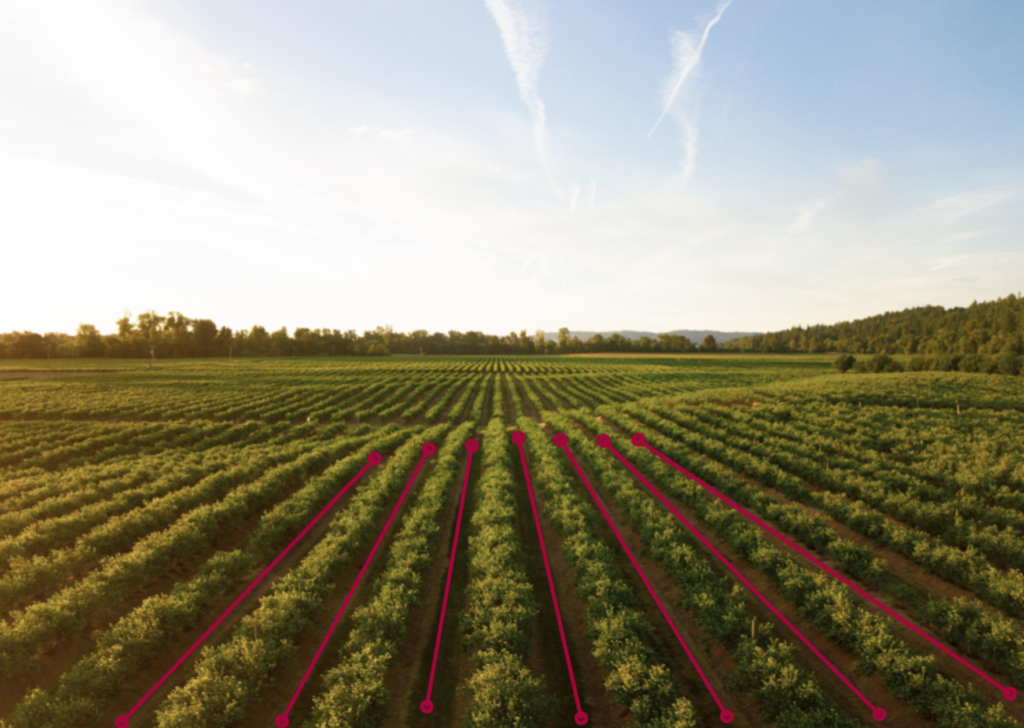Building and training image recognition models that are fit for industry implementation across various sectors is a science in itself. For this science to become a reality, it requires enormous amounts of data, which in this case is image data. The data sets require image annotation, also commonly referred to as image labeling, in order to make the data suitable for training machine learning models.
SentiSight.ai’s image recognition online platform is a place where AI enthusiasts, or those who require image recognition models for their industry, can annotate their image datasets on a mass scale no matter their experience or knowledge in the field of AI and machine learning.
The graphic below encapsulates the image annotation service provided by SentiSight.ai where users can make use of various features to perform image annotation tasks more efficiently.

This article will outline and focus specifically on the different labeling tool capabilities SentiSight.ai has to offer and their most popular use cases. The tools mentioned include:
- Bounding boxes
- Keypoints
- Polygons
- Bitmap and smart labeling
- Polylines
Image labeling – why do we need it?
Image annotation is a process of classifying images and creating labels to describe objects within them, resulting in high functioning object detection models through sufficient training. It is a crucial stepping stone in a supervised machine learning project because the quality of the initial data determines the quality of the final model. A mislabeled image could lead to the model getting trained incorrectly, consequently producing undesirable results.
To develop a neural network model well, data scientists are collecting vast amounts of data that contains hundreds of images. Therefore, labeling all of them correctly is a tedious, resource-heavy and lengthy process. The more people are working on the same project annotating, the more confusing it can get. Images can get duplicated, mislabeled or not labeled at all. Therefore, having a good management system is a must.
To make the image annotation process more efficient programmers have developed numerous data labeling tools that allow for quicker and more precise annotation. One of these powerful tools, called SentiSight.ai, is being offered by us.
What are the most popular types of image annotation?
1. Bounding boxes
In computer vision, there are several labeling options, ranging from the simplest to the most complex. The most commonly used type of annotation is bounding boxes. It works by applying rectangular boxes used to determine the location of an object and is represented by four coordinates marking its corners. However, using bounding boxes is not a very precise way to label images, since most of the objects are not rectangular.
Applications of bounding boxes include development of autonomous vehicles to detect other vehicles on the road, as well as, facial detection which can be used in workplaces for attendance monitoring, security and much more.
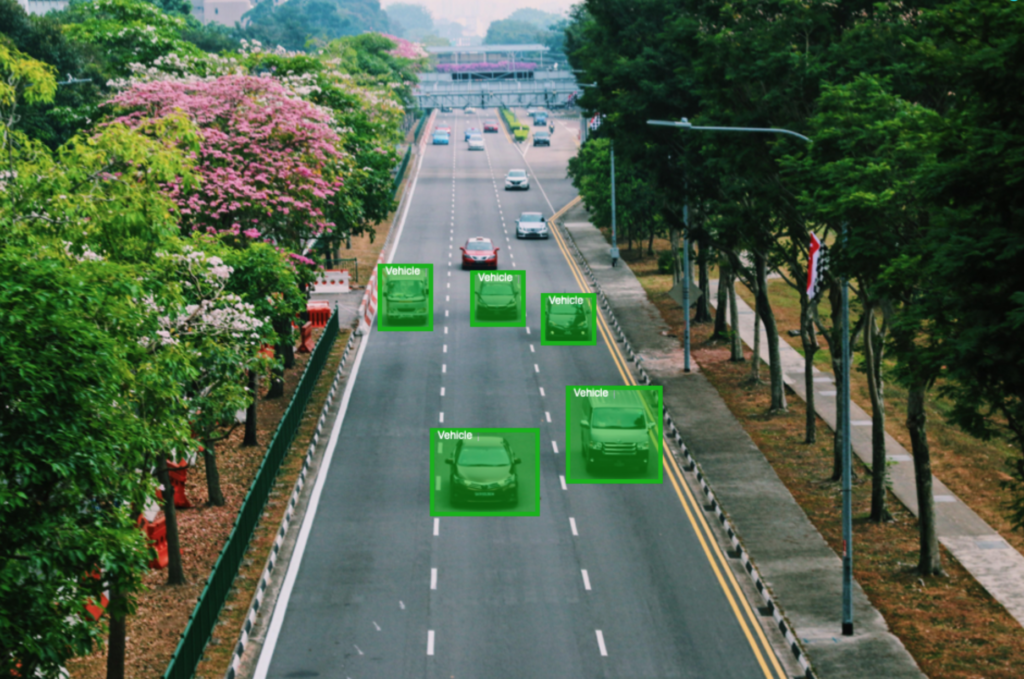
2. Keypoints
The keypoints feature is a sub-class of the bounding box tool. Once the user has drawn a bounding box around the object within the image, keypoints can then be selected to mark up any specific points within the image. Each keypoint can be assigned its own label, and after saving can be reused in the same order on another selection.
This labeling feature is useful for person detection & recognition. Using keypoints, more precise face recognition models can be trained than by using bounding boxes alone. These types of detections can be useful for voter registration, video surveillance or even employee time attendance systems.
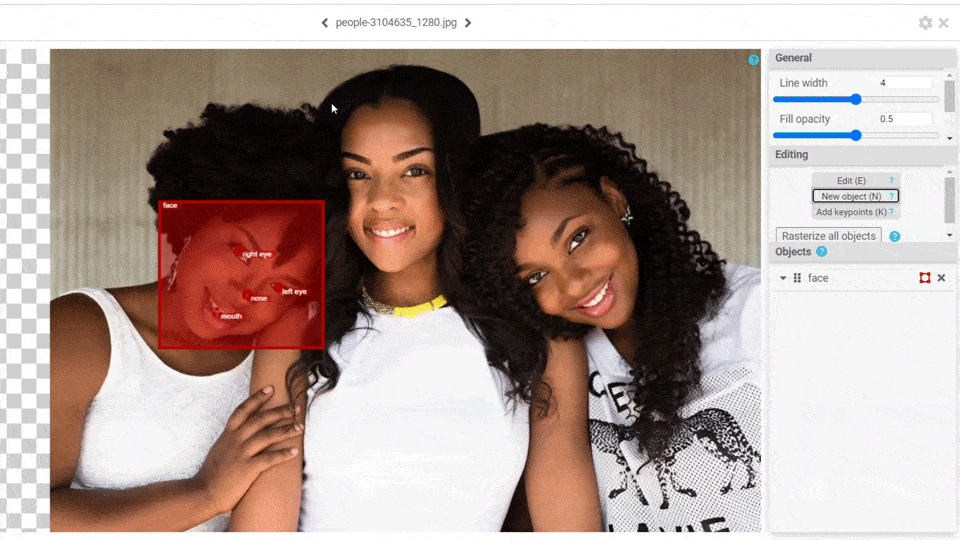
3. Polygons
Alternatively, our platform provides the possibility to accurately define the object by creating complex polygons around it. Editing them is possible by adding, moving or removing specific anchor points. The polygon annotation tool is useful while working with occluded objects since it can combine separate items into one joint structure or cut out holes in the initial selection.
Polygon use cases fall under the same bracket as bitmaps which are detailed below.
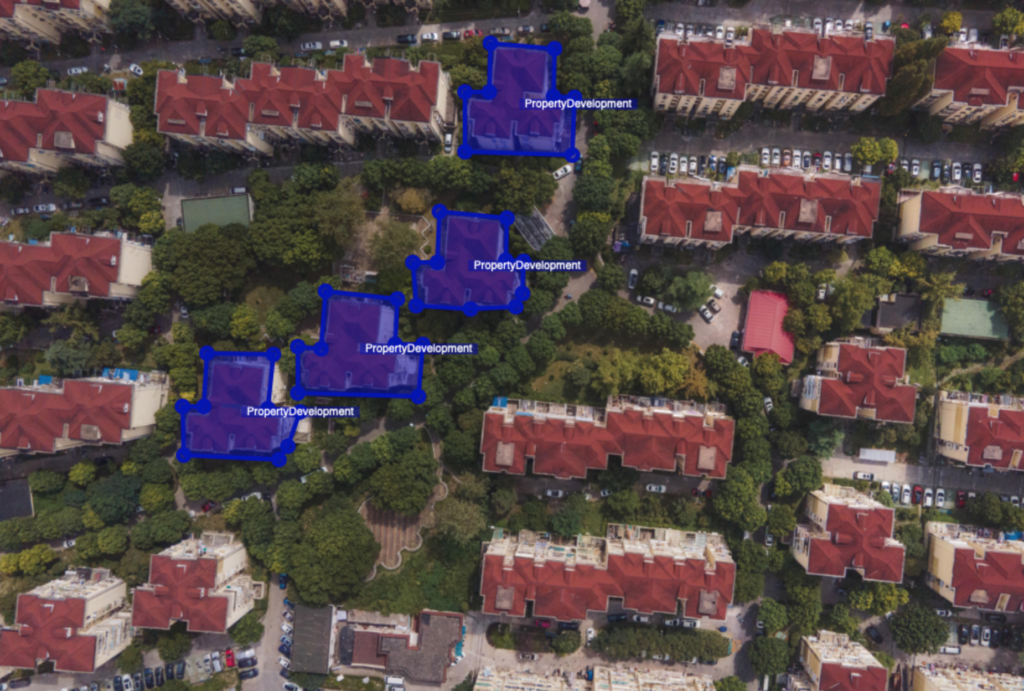
4. Bitmap and smart labeling
If users need to select an object of a complex shape, adding numerous separate points to form a polygon might become too difficult. For this task, free-form hand drawing bitmaps seems to be an easier option. It works similarly to a paintbrush, masking the selected area with a specific color that can then be converted to a polygon and vice versa to speed up the labeling process. The tool can be used as a drawing brush or an eraser, which helps to maintain accuracy.
In order to speed up the bitmap labeling process , SentiSight.ai offers an AI-assisted smart labeling feature similar to the ‘Magic Wand Tool’ in Adobe Photoshop automates the process. The only thing that needs to be done by the user is choosing the object area, vaguely defining both the foreground and background of the image using the given selection tools and then the AI algorithm does the rest by extracting the object. The tool works best with high contrast images, but even when the quality of the picture is only subpar, the process can be repeated as many times as needed to reach a satisfactory level.
Use cases of polygon and bitmap tools can vary from training autonomous vehicles to better understand their surroundings for optimal driving, identification of ripe crops that are ready for harvest, to medical imaging devices used for anatomy labeling such as brain imaging through CT scans.

5. Polylines
As the name suggests, the polyline tool is implemented when users wish to draw lines along the intended boundaries or edges within the image. Training a model on such data will enable you to recognize such edges on unlabeled images.
There are a number of use cases for polylines including outlining lanes on the road to make autonomous driving simpler for self-driving cars, as well as, optimizing crop yields in agriculture by firstly distinguishing each row and spotting weeds between the crops and within them.
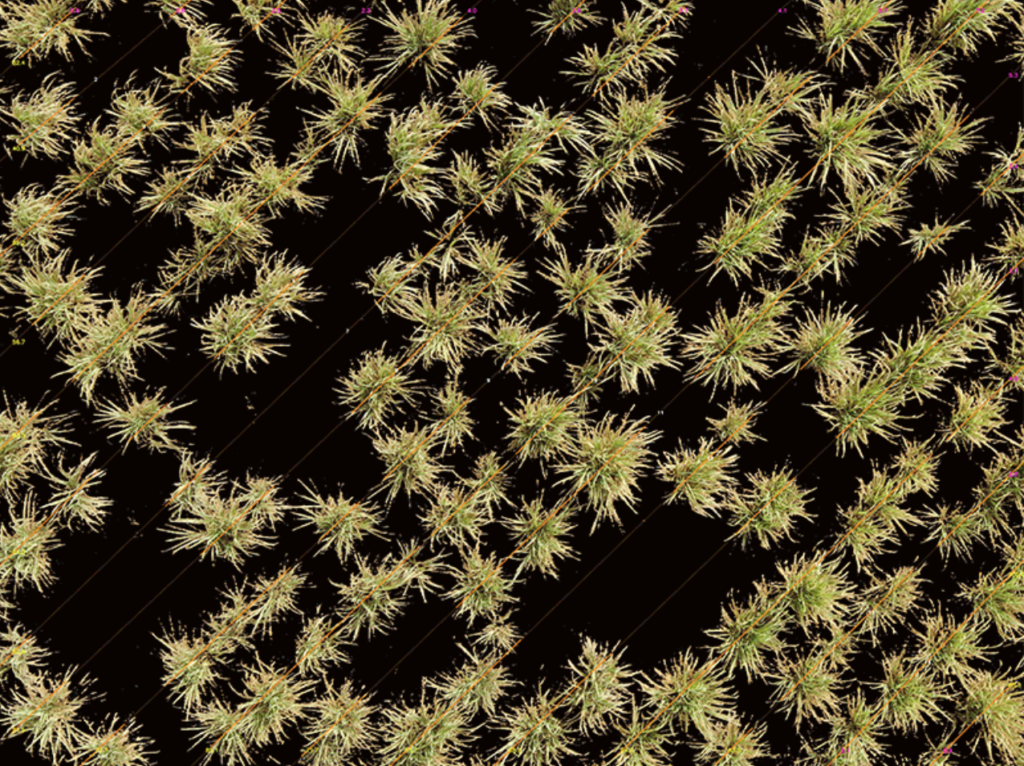
An easy way to label pictures quickly and efficiently
Featured tips and guides
By offering a user-friendly interface, SentiSight.ai makes image annotation tasks a lot easier. The visibility for all labels can be turned on or off and their opacity can be adjusted to help see objects behind them better. The tools have keyboard shortcuts that significantly speed up the labeling process. After finishing a task, all the selected labels can be downloaded in JSON or CSV formats. The colored bitmaps needed for semantic segmentation used in self-driving cars and robotics can be downloaded with the original images as well, the same goes for black and white bitmaps, used in instant segmentation. The platform is suitable both for beginners, providing a straightforward user guide as well as video tutorials, and experts who can improve their experience by using advanced features. Depending on the size of a project, SentiSight.ai is free to start, making it accessible to anyone willing to give it a shot.
AI-assisted tagging
To train a deep neural network model well, large datasets containing thousands, sometimes even millions of annotated pictures are needed. Labeling them one by one even with the help of useful tools is still time-consuming. Therefore, SentiSight.ai presents AI-assisted labeling that enables an iterative labeling process.
Tags, attributed through labeling, allow machine learning models of this kind to work brilliantly when implemented in various industries. For instance, image recognition for retail utilizes product tagging so users can shop online at ease with the categories being developed around tags of items.
To be able to work with it, the user needs to annotate a small number of images and train a neural network model with them, which can then be used to make predictions on the rest of the dataset. The platform then allows the annotator to review the results and correct specific labels if needed.
Already having annotations to choose from does not require the user to spend too much time coming up with new ones. Afterward, the images can be added to the training set so that a more accurate version of the model could be trained. Repeating the process with more pictures a few more times provides the user with better results with every iteration.
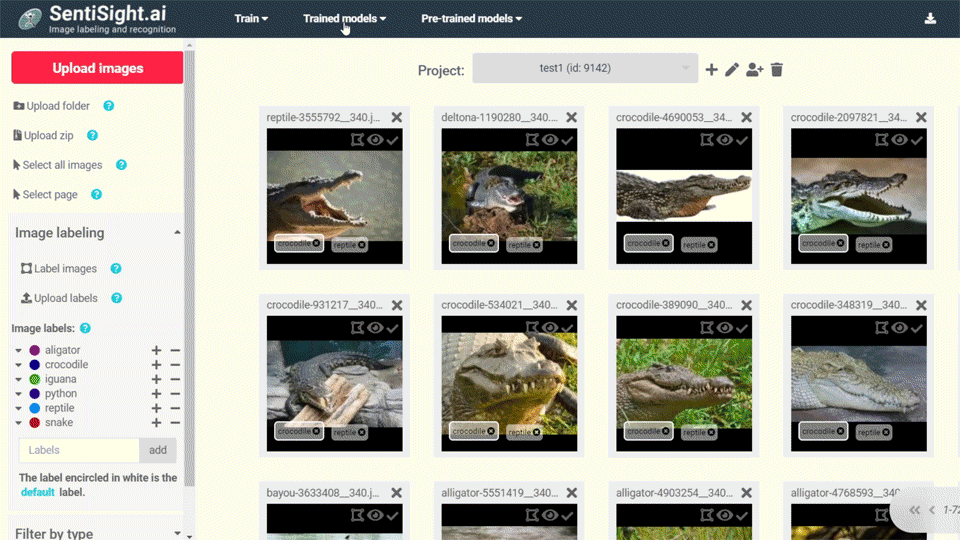
Convenient management system
As we are entering a new era of AI technology, using deep learning algorithms for autonomous vehicles, facial recognition and robotics, image labeling tasks are becoming more important than ever. Some projects require a huge number of images to be labeled, which cannot be done by one or two labelers. For this reason, not having a strong management system can prove to be a challenge for large teams working on a single project. While working on our platform, users can share projects within their team, supervisors can add new roles and manage permissions. They can also track the time spent labeling images, either by checking day to day statistics or the overall time spent on a project. These summaries can also be downloaded in CSV format. The platform allows users to filter images by type, as in ‘seen by you’, ‘labeled by you’, ‘marked as validation set’, etc, by names and by image status, which can be set to ‘seen’ or ‘labeled’ by particular team members to avoid duplication, track your work and remind what has already been done. If desired, images can be marked as ‘seen’ or ‘unseen’ by the user if the project guidelines have changed and annotation revisions are needed. Since SentiSight.ai is an online tool, everyone’s work can be checked by their supervisor in real-time.
The power of sight
The ability to see and understand what we see comes naturally to humans, and so we tend to take it for granted. However, teaching someone else, especially a machine, to perceive things as we do is a long and laborious process. In computer vision, correctly describing the ground truth is a critical task requiring careful consideration. Therefore, whether you are training models for single label classification, multi label classification or various other requirements, a straightforward and quick process is vital. Image labeling platforms such as SentiSight.ai are here to help by offering powerful tools, assisting to improve the technology we currently have at our disposal.
